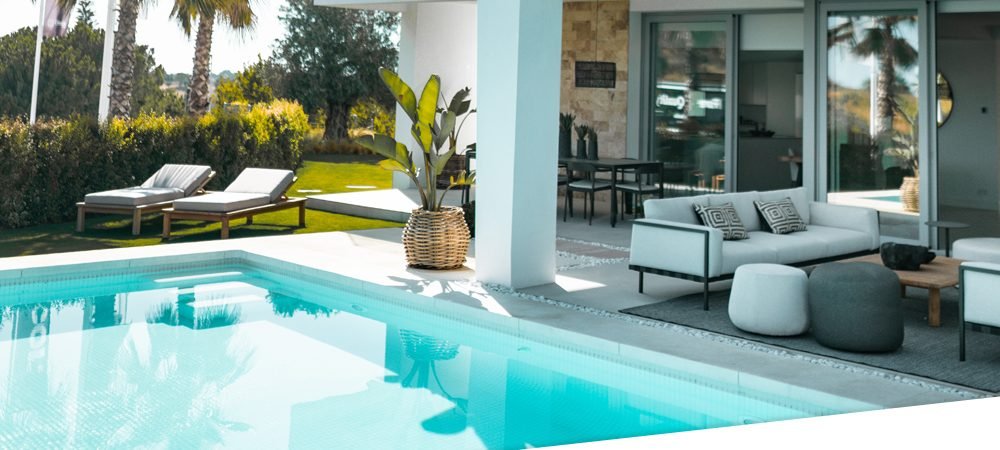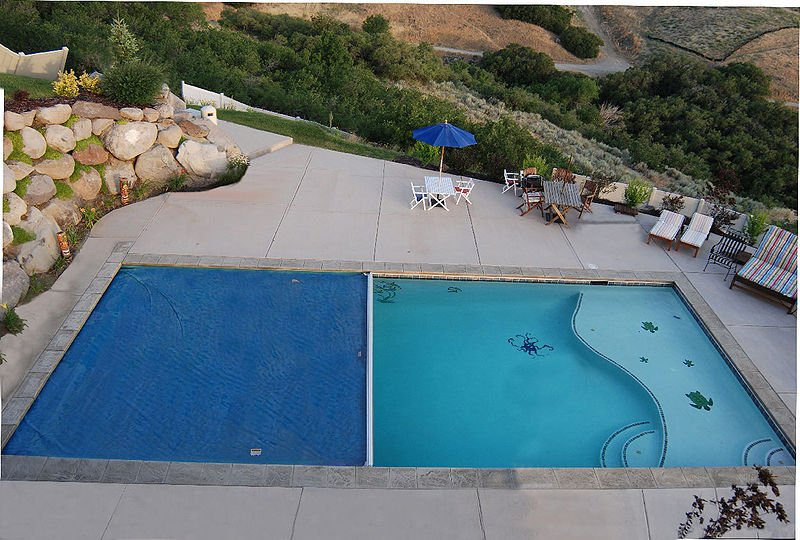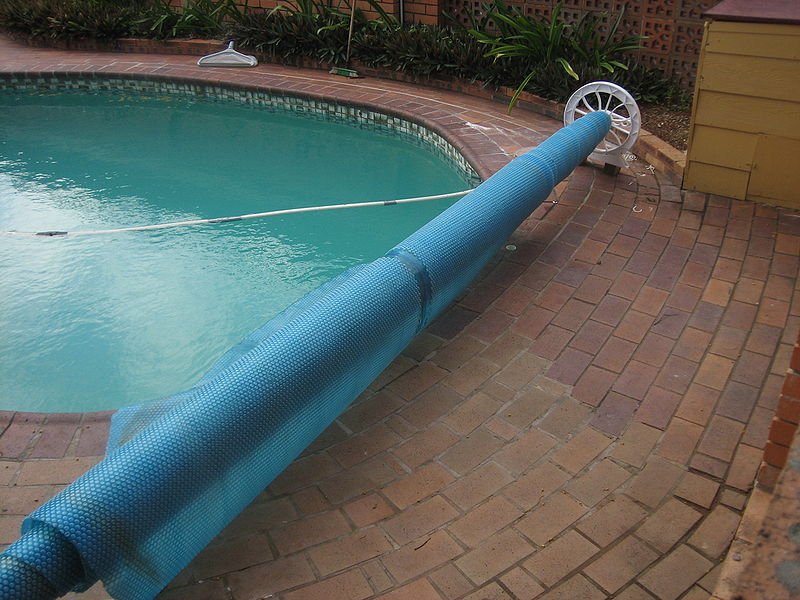
Investing in the right type of pool cover is important for maintaining a clean, safe, and energy-efficient swimming pool. Pool covers are a versatile addition that not only preserves your pool’s water quality but also reduces energy consumption and provides safety.
Let’s explore the different types of pool covers by uncovering their features, benefits, and drawbacks to help you make an informed choice for your aquatic oasis.
Types of Pool Covers
1. Solar Pool Covers
Solar pool covers, often called bubble covers or solar blankets, are designed to trap the sun’s heat and reduce water evaporation. They feature a series of air bubbles that act as insulators, retaining heat and preventing heat loss during the night.
Pros
- Solar covers can raise your pool’s temperature.
- They reduce water evaporation, conserving water and reducing the need for frequent refilling.
- They cut energy costs by decreasing the need for pool heating.
- They shield your pool from debris, leaves, and bugs, making maintenance more manageable.
Cons
- Solar covers offer minimal safety features and must be used alongside other safety measures.
- They require regular removal and storage to access the pool, which can be hectic.
2. Winter Pool Covers
Winter pool covers are designed to safeguard your pool during the off-season, providing protection against harsh weather conditions and debris. They are typically made of heavy-duty, UV-resistant fabric or solid vinyl material.
Pros
- Winter covers protect your pool from freezing temperatures, ice, and snow, preventing damage.
- They shield the pool from falling leaves and debris, making spring reopening easier.
- Winter covers help maintain water quality by reducing the accumulation of contaminants.
Cons
- Installation can be labor-intensive and may require additional water bags or weights to secure the cover.
- Winter covers don’t offer convenience for those who want to use the pool year-round.
3. Foam Pool Covers
Foam pool covers, known for their insulating properties, create a thermal barrier to reduce heat loss from pool water, resulting in energy savings and an extended swimming season. Easy to install and customize, they are a cost-effective choice for maintaining water temperature. Still, they offer limited debris protection and no safety features, making them best suited for those primarily seeking energy efficiency and an elongated pool season.
Pros
- Foam covers provide excellent insulation, reducing heat loss and keeping the water warm.
- They conserve energy by reducing the need for pool heating.
- Foam covers are easy to install and remove, making them convenient for daily pool use.
Cons
- While they offer insulation, foam covers may be less effective at blocking debris or preventing evaporation.
- They don’t provide safety features and must be used in conjunction with other safety measures.
4. Mesh Pool Covers
Mesh pool covers are popular among pool owners as they effectively block debris while allowing rainwater to pass through. Made of durable porous mesh material, they prevent larger debris from entering the pool and inhibit stagnant water accumulation, reducing the risk of algae growth.
These covers offer convenience and save time on cleaning and maintenance. Their sturdiness and durability make them a cost-effective, long-term investment for cleaner pool water during the off-season.
Pros
- Mesh covers effectively block leaves and larger debris, keeping the pool cleaner.
- They reduce the risk of algae growth by allowing rainwater to pass through, preventing stagnant water.
- Installation and removal are relatively easy and don’t require additional weights in most cases.
Cons
- Smaller debris like dust and dirt may still enter the pool through mesh covers.
- They don’t provide insulation or heat retention and may require occasional cleaning and maintenance.
5. Solid Vinyl Safety Pool Covers
Solid vinyl safety covers are engineered to provide a secure barrier against unauthorized access to the pool. They are typically made of durable solid vinyl material and anchored securely to the pool’s deck.
Pros
- Solid vinyl safety covers adhere to stringent safety standards, ensuring a secure pool environment.
- They effectively prevent debris, leaves, and contaminants from entering the pool.
- These covers reduce maintenance and maintain water quality, making them a well-rounded choice.
Cons
- They are more expensive than other cover types and may require professional installation.
- Solid vinyl safety covers must be used in combination with other safety measures to be fully effective.
6. Automatic Pool Covers
Automatic pool covers are a high-tech solution that combines convenience, safety, and energy efficiency. These covers feature an automated system for effortless opening and closing, providing security by making the pool inaccessible and significantly reducing evaporation, heat loss, and debris entry.
While they offer outstanding benefits, they are more expensive and may require professional installation. This makes them ideal for those who prioritize ease of use and comprehensive pool protection.
Pros
- Automatic covers provide safety and security with the push of a button, making the pool inaccessible to children and pets.
- They reduce maintenance and protect the pool from debris, evaporation, and heat loss.
- These covers are user-friendly and provide the convenience of easy operation.
Cons
- Automatic covers are typically more expensive than manual covers.
- They may require professional installation and maintenance.
Manual Pool Covers
As the name implies, manual pool covers require manual effort to cover and uncover the pool. They come in various forms, such as roll-up covers and folding covers.
Pros
- Manual covers offer convenience and protection, striking a balance between ease of use and cost-effectiveness.
- They reduce the risk of accidents by acting as a barrier, preventing access to the pool.
- Manual covers are typically more budget-friendly than automatic options.
Cons
- They require physical effort to operate, which may not be suitable for all pool owners.
- While they provide a layer of protection, they may not be as secure as automatic or safety covers.
- Manual covers may take more time to put on and take off, potentially impacting the spontaneity of your swimming plans.
Benefits of Pool Covers
Water Conservation
Pool covers act as a protective shield, significantly reducing water evaporation. This conserves water and reduces the need for constant refilling, which can lead to significant water savings, particularly in arid regions.
Energy Savings
Pool covers provide insulation for your pool, reducing heat loss and the need for constant heating. This, in turn, leads to substantial energy savings and reduced utility bills, making your pool more environmentally friendly and cost-effective.
Enhanced Safety
Safety covers, in particular, are designed to provide a secure barrier, preventing accidental entry into the pool. They are crucial for families with young children or pets, offering peace of mind and ensuring a safe pool environment.
Reduced Maintenance
Pool covers act as a protective shield, preventing debris like leaves, twigs, insects, and dirt from falling into the pool. This keeps your pool cleaner and reduces the time and effort required for regular maintenance and cleaning.
Cleaner Water
By keeping out debris, pool covers help maintain water quality. This means you’ll spend less time and money on chemicals and filtration, ensuring your pool water remains crystal clear.
Extended Swimming Season
Solar pool covers, also known as bubble covers, can raise the temperature of your pool water by several degrees. This allows you to start your swimming season earlier in the spring and extend it later into the fall.
Reduction in Chemical Usage
With less debris and sunlight exposure, your pool’s chemical balance remains more stable. This reduces the need for chemical adjustments, ultimately saving you money and improving water quality.
Environmental Benefits
Solar covers use the sun’s energy to heat your pool, reducing the need for conventional energy sources and decreasing your carbon footprint. They are an eco-friendly choice for environmentally-conscious pool owners.
Protection Against Harsh Weather
Winter covers shield your pool from the harsh elements of winter, preventing damage from freezing temperatures, ice, and snow. This can extend the life of your pool and its equipment.
Cost Savings
While there is an initial investment in purchasing and installing a pool cover, the long-term cost savings in water, energy, chemicals, and maintenance make it a financially wise decision.
Conclusion
The pool cover you choose should align with your unique needs, budget, and priorities. Let us recap so it can be easier for you to decide. Solar covers are excellent for heating and reducing evaporation, while winter covers offer protection during the off-season. Foam covers provide insulation, mesh covers keep debris out, and solid vinyl safety covers prioritize security. Automatic pool covers offer the utmost convenience, and manual covers strike a balance between ease of use and cost-effectiveness.
Whether you prioritize warmth, safety, or simplicity, there’s a pool cover type that’s the perfect fit for your needs. By making an informed choice, you can enhance your pool ownership experience and enjoy the benefits of a well-protected and efficiently managed swimming pool.












